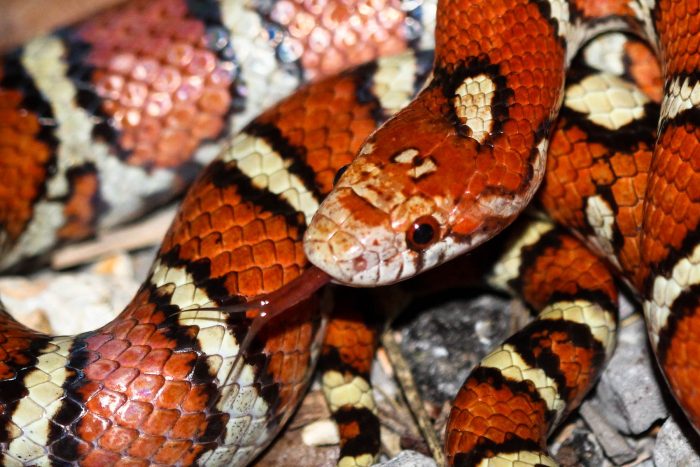Eastern Milksnake
Lampropeltis triangulum
The eastern milksnake is a secretive creature that spends most of its life underground or under rocks and logs.
This section shows one large critter image at a time. Use the thumbnails that follow to select a specific image to display here.

This gallery contains a grid of small thumbnails. Selecting a thumbnail will change the main image in the preceding section.
Appearance
The eastern milksnakes appearance can vary greatly, especially in different geographical ranges. It has red, brown or copper spots on its back and each spot has a black border. The base color of the snake is a cream or light gray color. Its belly will have a checkerboard pattern.
Each snake will show its most vivid coloration when it hatches and will get darker as it ages. Milksnakes have round pupils. They often have a white nose and a dark spot in the shape of a “Y” or “V” on the back of their heads.
Feeding
Milksnakes are constrictors that will wrap their bodies around their prey and hold it until it stops breathing and dies. They will then eat the prey whole. When they are young, milksnakes commonly eat other small snakes, amphibians and insects. They will eat more birds and rodents as they get older.
Predators
Predators of the eastern milksnake include opossums, skunks, raccoons, hawks, owls and coyotes. The snake will mimic the colors of both the venomous coral snake and venomous copperhead, which can keep it from being preyed upon. They have also been known to shake their tails to mimic rattlesnakes when threatened.
Reproduction and life cycle
Milksnakes spend their winters in communal dens underground. They are in a state known as brumation, which is a state of dormancy similar to hibernation. When the temperature rises, the snakes will emerge from their dens and mate, usually from April to June. The females will lay their eggs under logs or buried several inches deep in the soil.
Each female will lay two to 17 eggs each year. Smaller snakes lay fewer eggs and larger snakes lay more eggs. The eggs will hatch in late summer or early fall, and hatchlings will be about four to eight inches in length. Snakes reach sexual maturity at three to four years old.
Did you know?
- The genus name, Lampropeltis, translates to “shiny shields” in Greek, which might be referring to the shiny smooth scales of the snake.
- The common name of milksnake most likely came from a myth that the snakes were stealing cow’s milk, since they were commonly seen in barns. In reality, the snakes were there to eat rodents that were also inhabiting the barns.
- The non-venomous milksnake can be differentiated from venomous copperheads because the milksnake has round pupils instead of vertical slits, round blotches with borders in comparison to the hourglass shape seen on copperheads, and a checkerboard pattern on their stomach instead of a solid cream color.
Sources and additional information
- Milk snakes - Virginia Herpetological Society
- Eastern Milksnake - PA Herps
- Field Guide to Maryland's Snakes - Maryland Department of Natural Resources
